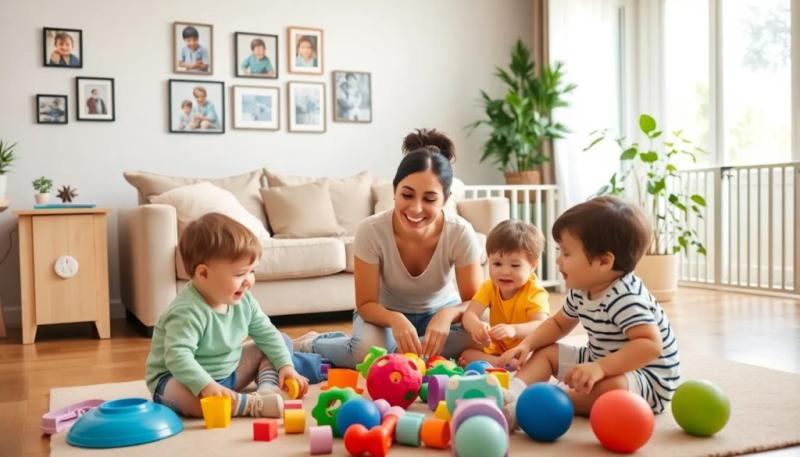Ensuring a safe environment for children is a top priority for every babysitter. This guide outlines best babysitter childproofing practices that will help caregivers provide a secure space for little ones. From identifying hazards to promoting safe sleeping practices, these steps are essential for any babysitter.
By being proactive and well-prepared, babysitters can effectively prevent accidents and create a nurturing atmosphere for children. Let's explore the crucial aspects of creating a childproof environment.
Identifying potential hazards in the home
Understanding potential hazards is the first step in creating a safe environment. Common risks include sharp objects, electrical outlets, and chemicals. Babysitters should conduct a thorough inspection of the home to identify these dangers.
Make a checklist of potential hazards, such as:
- Unsecured furniture that can tip over
- Exposed cords and wires
- Small items that could pose choking hazards
- Hazardous materials stored within reach
After identifying these hazards, it’s crucial to take immediate action to mitigate risks. This may involve moving furniture, securing cords, or storing dangerous items out of reach. By being vigilant, babysitters can greatly reduce the risk of accidents.
Creating a safe play area
Designing a safe play area is essential for keeping children entertained and secure. A designated space should be free from any potential dangers. Start by selecting a room or area that is easy to supervise.
Consider the following tips when creating a safe play area:
- Use soft mats to cushion falls.
- Ensure toys are age-appropriate and free from small parts.
- Install safety gates to block off unsafe areas.
- Remove any breakable items from reach.
By following these recommendations, babysitters can create an engaging and safe environment where children can play freely without constant concern for safety.
How to start babyproofing
Babyproofing should begin as soon as a babysitter enters a new environment. It is crucial to assess the space and make adjustments before the children arrive. Start with a visual walkthrough, noting any immediate concerns.
Babysitters can follow these steps to effectively babyproof a space:
- Cover electrical outlets with safety plugs.
- Secure furniture to the wall to prevent tipping.
- Store cleaning supplies and medications out of reach.
- Keep sharp objects in locked drawers or cabinets.
Implementing these measures early on can help ensure a safe experience for both the babysitter and the children in their care.
Best babysitter childproofing practices
Implementing the best babysitter childproofing practices requires a comprehensive understanding of child safety. Consistent supervision is key, along with regular safety checks. Here are some essential practices:
Firstly, always ensure that children are within sight and hearing distance. This is crucial for maintaining supervision and quickly responding to any incidents.
Additionally, consider these childproofing tools:
- Corner guards for sharp furniture edges.
- Cabinet locks to secure hazardous materials.
- Safety gates to restrict access to stairways.
Staying informed about new child safety products can enhance a babysitter's ability to provide a safe environment. Continuous education and adapting to new practices are essential for effective babysitting.
Promoting safe sleeping practices
Safe sleeping practices are vital for infants and toddlers. Babysitters should adhere to guidelines that prevent sleep-related accidents. This includes placing babies on their backs to sleep and using a firm mattress without loose bedding.
Follow these recommendations for safe sleeping:
- Keep the crib free of toys and soft objects.
- Ensure that the crib meets safety standards.
- Monitor room temperature to prevent overheating.
By emphasizing safe sleeping habits, babysitters can ensure children rest well while minimizing risks associated with unsafe sleeping environments.
Preparing for an emergency
Being prepared for emergencies is crucial for any babysitter. This includes having a basic understanding of first aid and knowing emergency contact numbers. It’s essential to have a plan in place for various scenarios, such as injuries or natural disasters.
Babysitters should consider the following:
- Know the location of first aid supplies.
- Have emergency contact information readily available.
- Establish a clear plan for fire or severe weather emergencies.
Practicing these preparedness measures can significantly improve a babysitter's ability to respond effectively in any emergency situation.
Tips for babyproofing around the house
Babysitters can enhance safety throughout the house by taking specific steps. Each room presents unique challenges, and it’s important to tailor babyproofing efforts accordingly. Here are some key tips:
In the kitchen, keep sharp objects and cleaning supplies out of reach. Use stove knob covers to prevent children from turning on burners.
In the living room, secure heavy furniture to the walls and keep cords from blinds or electronics out of reach. This helps prevent accidental injuries.
Lastly, ensure that bathrooms are safe by installing non-slip mats and keeping medications locked away. Taking these precautions can help maintain a secure environment throughout the house.
Questions related to babysitting safety practices
How much should a babysitter charge for 5 kids?
The cost of babysitting can vary depending on various factors such as location, experience, and the number of children. Generally, babysitters may charge between $15 to $25 per hour for multiple children. However, rates can go higher for additional responsibilities or specialized care.
It's essential to discuss rates upfront with the parents and consider local standards to ensure the price is fair for both parties.
What is the number one rule in babysitting?
The number one rule in babysitting is to keep the children safe at all times. This encompasses constant supervision, ensuring a safe environment, and being prepared for emergencies. Babysitters should be attentive and ready to respond to any situation that may arise.
By prioritizing safety, babysitters can create a trusting and secure environment for both the children and their parents.
What are the safety tips for babysitting?
Some essential safety tips for babysitters include:
- Always supervise children, especially near water or stairs.
- Know the family's emergency plan and contact numbers.
- Be aware of any allergies or medical conditions children may have.
Implementing these safety practices can significantly reduce risks and create a safe space for children.
How many kids can a babysitter legally watch?
The legal limit for how many children a babysitter can watch varies by state and local laws. Typically, babysitters can care for up to four or five children at one time, depending on their ages and any special needs. It’s important for babysitters to be aware of local regulations to ensure compliance.
Adhering to these guidelines helps ensure that each child receives adequate attention and care, promoting a safer environment.




